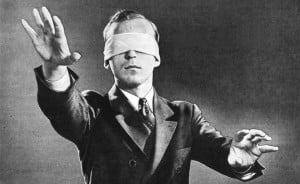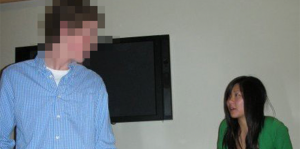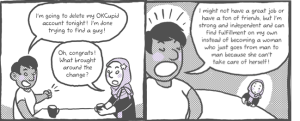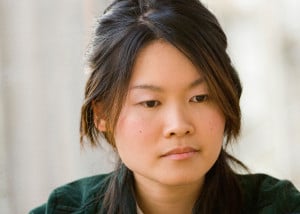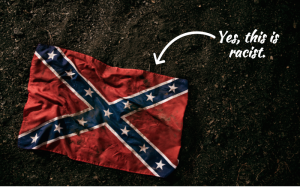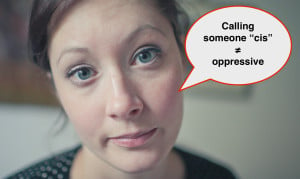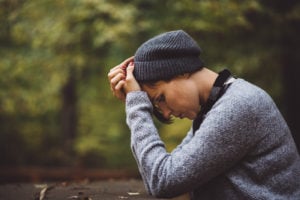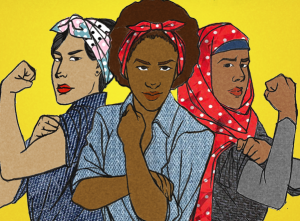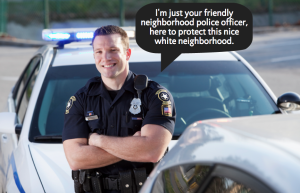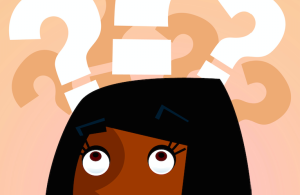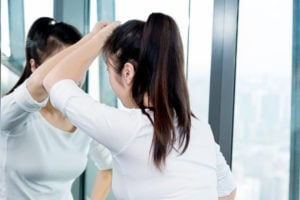
A person leans against a mirror, their arm obscuring the reflection of their face.
(Content Warnings: body dysmorphia, eating disorders, sexual violence, alcohol consumption, hospitalization, mentions of suicide and imagined self-harm, idealization of thinness, childhood sexual abuse)
Sometimes a mirror is just a mirror. Sometimes my reflection is just a reflection and not a reflection of me.
Sometimes I’m just getting ready for a shower. There are even moments I admire the uninterrupted plane of porcelain that is my skin, the elegant curve of the bend under my knee, my cascading red curls.
But sometimes I catch a glimpse of this flesh at the wrong angle and I’m shaken.
It’s like swallowing the butt of a gun – that feeling. Like I’m on the brink of an end, there, naked in my bathroom. How close I always am to some end.
I see the way my body bulges and slopes, not an angle in sight, and I can’t stomach it. I look down. I picture a knife in my hand. The big kind, for chopping. I can use it to carve myself down into something easier for society to swallow.
I picture my other hand grabbing chunks of unwanted flesh and the knife slicing them off. Gone. Thin. Beautiful. They’re all the same, aren’t they?
The thought doesn’t hurt. How badly I want to disappear. How badly I want for no one to see me. The pain doesn’t scare me. The blood doesn’t scare me. I would do it if it were that simple. But the knife would leave scars.
I squeeze my eyes shut. I turn on the water, scalding hot. I step into the shower. A girl doing her best to burn the thoughts out, to forget she has a body to hate.
I touch myself in the shower and disbelieve the animal force of myself.
I get out of the shower. Sometimes I get out of the shower someone else, but that someone else is still somehow always me. There are words for this. I stand in front of the mirror, nude. I do it often. Not out of vanity, but trying to reconcile that this is my reality.
My body: the realest thing I know. What it is capable of. Such pleasure. Such pain. It is the reality I live within, but reality is something I’ve always wanted to escape.
Tonight, I want to escape. This flesh. These curves. The world – how it goes dead still when I look at myself. There are words for this.
I know that others see this reality differently than I do, but I still just see that flesh, those curves. Our culture has had to create words for people like me: Body Dysmorphic Disorder (BDD).
But it’s impossible to believe that that’s real and what I see when I look in the mirror isn’t. My body. How many times I have tried to leave it. How many ways. This is one.
When a person has BDD, they become hyper-fixated on perceived flaws or defects that aren’t even apparent to others.
***
My body is not something to be lived in or lived through. My body is here for consumption. Their consumption. The masses. The men, always like the ones I’ve known before. The long gazes across crowded bars, this is what I’m here for.
But other reasons won’t allow me to let it be consumed by that. I have already given too much to men who only knew how to take.
This is what’s left of me, this mangled silhouette of what might have once one day been a woman if it had grown right, lived wrong, or eaten so much. And if my body will not be consumed by the culture, I will allow it to consume itself.
The only way I knew how to inhabit my body was in my sexuality. I could squeeze my eyes shut and rub myself for hours and hours, nearly shuddering out of myself, shocked by the way my body was in every way just a body then.
The screaming animal that was my orgasm felt like a safe place to be. It felt like the closest thing to being held. And how badly I wanted to be held.
The swell of hunger is much like the swell of sex: It aches in the good way. The feeling grows and complicates and eventually ends in satisfaction. The surrender. To a man, his touch. To my own. To finally eating, even if it’s a only slice of honeydew. I learned to love the hunger. I learned to crave it.
The disorder makes having healthy sexual relationships extremely difficult due to poor self-image.
***
The disorder does not discriminate. It affects people of all genders, people of almost any age (as early as 4 or 5, although it most often begins around age 12 or 13), people of any race and ethnicity, people from around the world, people from all socioeconomic classes and body types.
We want disorders like this, the invisible ones, to be independent. We don’t want to think of why someone may have body dysmorphia. We want these things to stand alone. There is safety in isolation.
Most of all, we want disorders like this to stay silent.
We don’t want to think of what small wounds or cascading traumas came before the distorted image of self. We don’t want to think of the moment or the way we saw our bodies changed.
It is so often connected to what the media feeds us. The media has jammed down everyone’s throat what we’re supposed to look like here. Thin, a wisp of a waist. Beautiful, seemingly effortless, but achieved through multiple means and processes: fashion, makeup, fitness, eating disorders.
They don’t care how we got there, as long as we look good.
I have always been an overachiever.
At 18, at 5’8”, I was wasting away just like I thought I was supposed to. I had breasts and an ass, and made the 18-year-old mistake of interpreting a guy’s comment that I “have a porn star’s body” as a compliment.
We are here for consumption. And then, I was consumed, even if not consuming.
I hated myself beyond language then.
***
I used to be mesmerized by my face in the mirror, the fact that I had eyes, before it hurt so bad to look at myself.
I would stare into my other self for hours, stomach gnawing away at itself. I was smaller then. I liked that when I looked in the mirror, it seemed like I was the only person in the world. The door was shut, locked. The lights dimmed. Dallas Green blasting against the walls the color of mangoes.
In that room, alone, it felt okay to exist.
Existing is different from living.
To live, you have to risk being seen.
***
The second time I was consumed, I was 18 and drunk off of the vodka, Mountain Dew, and maple syrup cocktail mixed for me by the blonde guy with the eyes that looked like gunmetal.
I was drunk for the first time, sprawled naked on a bathroom floor with a boy’s head between my legs when I didn’t ask him to be there.
I didn’t remember getting there. He handed me a bottle of lotion and took off his pants. I was obedient. I was drunk and loud and accidentally bad for a night. I was not in my body. All I was was a body. The girl in me wasn’t there that night.
All he said was, “At least you’re hot.”
I was small. I was easy to swallow. Mostly bone. I was easy to keep quiet once morning light came.
I carry this in my body.
***
I was diagnosed with BDD during my first stay in a mental hospital.
Seventeen years old, trapped for five days in the white hallway of an adolescent psychiatric care facility: seven diagnoses, five prescriptions, everything hazy. I was smaller then. I had been smoking myself and that body away for months.
Death has never scared me. It’s why I was there. I walked down the hall my first morning there, and as I passed, someone said, “You’re pretty.”
“Pretty” and “skinny” have always sounded like the same thing to me.
I am best when I am wasting away. Otherwise, I am taking up too much space. I am not entitled to that. I am not entitled to anything. I am here for consumption.
People with BDD are deeply distraught by thoughts that they look abnormal. Most also suffer from anxiety and depression, either as a result of living with the disorder or as a result of the chemical imbalance that likely contributes to their BDD.
Many of us abuse alcohol and drugs, engaging in extremely self-destructive behavior to try to diminish thoughts of our bodies. Anything to escape. Many even attempt or commit suicide.
***
The first time I was consumed, I was 4. I didn’t let myself remember until I was 20.
My father. My bedroom. His body blocking the nightlight. His hands. It always seems to be a man who steals a girl’s body from her, or steals her from herself. With him, I was quiet and small and pretty. I was a good girl.
I carry this in my body.
Certain factors seem to increase the likelihood of developing BDD. Among these is childhood sexual abuse.
My father wanted to pretend he was still a father and didn’t have sick hands. The boy with the mouth and the metal eyes wanted my truth to disappear like I did that night. The doctor in the hospital wanted naming the disorder to make it shrink, like I did.
I was so good at shrinking for men.
We are here for the masses. This is how they want us. Small and pretty and quiet.
***
There was a day my face in the mirror changed.
I wish I could tell you when it was, but all I know is that there was a day I could no longer look only there, but had to take in my body as well.
My face was no longer the sculpted glowing thing it had once been. It wasn’t my face anymore, but there it was staring back at me, so what else could it be? I always looked different after being touched.
For years, I didn’t have the words.
Body Dysmorphic Disorder. I didn’t know there was language for this shift. I only knew that whenever I saw myself, in the mirror, in photographs, passing by a window, it looked like I was seeing it through a funhouse mirror that twists and distorts the image.
Parts of me were missing, parts that shouldn’t be there were added on, and the parts that should be there were somehow wrong. There I was, a circus freak in my own bathroom.
These were the bad days when nothing I said made any sense, too consumed by all that my body was and wasn’t.
***
There have been months at a time when I didn’t leave my house.
When I was 15. When I was 19. When I was 21.
My biggest fear was being seen, and wherever I go, my body goes with me. So I stayed. In bed. In the dark.
Away from mirrors, pushing out the memory of the image of myself and trying not to imagine how much worse I might look then, makeup-less and hair matted from days spent with my head on the pillow, under the covers, hidden away from the world.
My body, its grotesque formation, became my biggest secret. I showed it to no one. I denied its existence.
I refused to feed it, wilting and wilting and wilting, night after night. It always seemed like night then.
The earliest documentation about the disease dates back to 1891. Many with BDD believe others are fully aware of this perceived flaw. We may assume that passersby are laughing at us or outright pointing at our supposed flaw, and that our friends and family perceive us as ugly or repulsive.
Hiding in the night was the only thing that made any sense.
***
Obsession with mirrors is another common symptom of BDD.
Patients may find that they stare in the mirror for hours, and may also seek out any reflective surface to look at their perceived flaw: “This can include spoons, soda bottles, dinner plates, windows, and the like.”
***
I am now in a “healthy” weight range, still 5’8” at 22 and still in front of this same goddamn mirror.
My body is all rounded edges and pale, glowing flesh. My body is probably now the reality of what I used to fear I was. And what am I beyond a body?
There are days when I look directly in the mirror, and all I see is a girl. I may not recognize her, but she’s there, staring back at me. Sometimes, she even hints at a smile.
In some ways, I am a girl again.
Maybe, in some ends, we just restart from the beginning.
[do_widget id=’text-101′]
Summer Krafft is a writer, performer, event coordinator, arts advocate, and student based in California’s Central Valley. Her previous work can be seen in NAILED Magazine, The Manifest-Station, Penumbra, RoleReboot, YourTango, and The ModestoView. Her work tends to deal with themes of love, rage, forgiveness, and the body.
Search our 3000+ articles!
Read our articles about:
Our online racial justice training
Used by hundreds of universities, non-profits, and businesses.
Click to learn more





